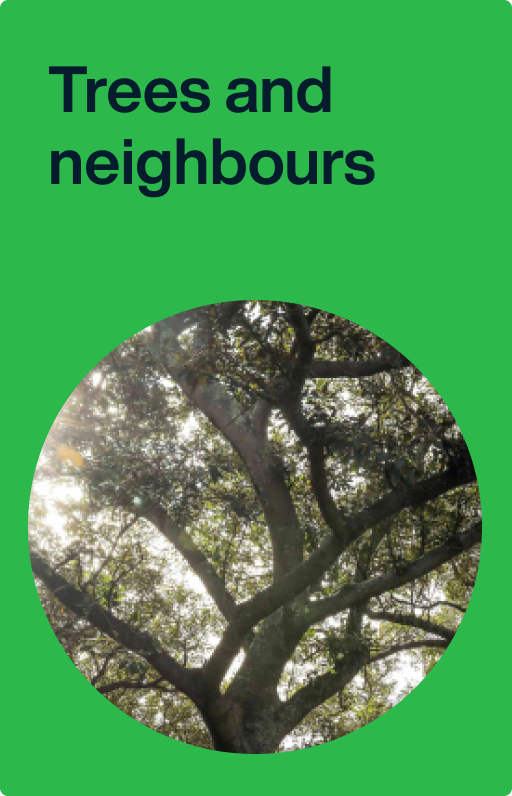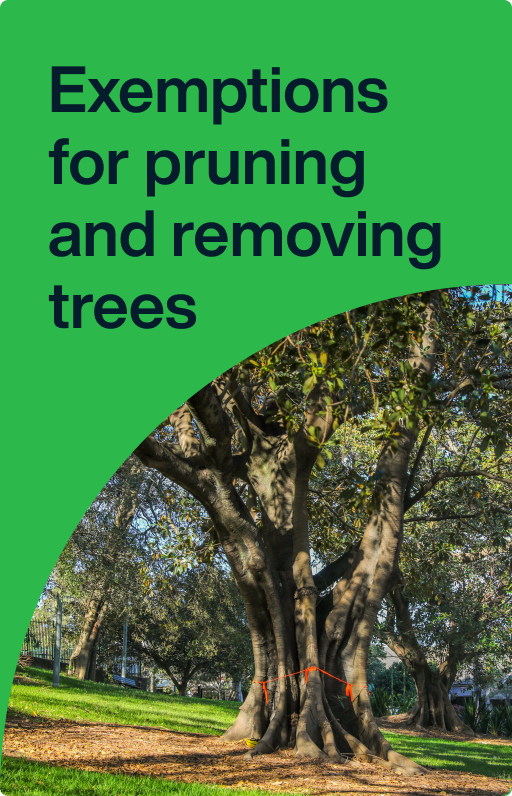Apply to prune or remove a tree
Project Status: When you need to do this
Before you prune or remove a tree from your residential or business property you must apply for permission. Depending on the tree species, its condition or the type of pruning required, some exemptions may apply.
Our tree management controls aim to protect individual trees and the urban forest.
What you need to do
-
Check if the tree is protected
If you want to prune or remove a tree on private property, you should check to see if it's a heritage item or protected under the development control plan.
This will determine if a permit or development consent is required. Typically, heritage-listed trees require development consent, while trees protected under the development control plan require a permit.
Some trees are exempt and do not require a permit or development consent to be pruned or removed. Check if any exemptions apply.
-
Applying for a permit
If you need to apply for a permit, you will need to lodge a prune/remove tree application, including the $95 application fee.
-
Applying for development consent
If you need development consent, you will need to lodge a development application, including the $129 application fee and $650 notification fee.
Pruning trees in your neighbour's yard
Before you prune branches overhanging from a neighbour’s tree, you need to lodge an application with us. Permission from your neighbour is not required but we recommend you let them know as a courtesy.
Pruning a neighbour's tree back to the property line is not permitted as it will damage the tree. All pruning must conform to the Australian Standard for the Pruning of Amenity Trees (AS4373).
Before you start
Penalties for pruning and removing trees without a permit or consent
It's an offence to remove or prune trees without a permit or development consent.
Depending on how serious the offence is, you may be issued with a penalty infringement notice, or prosecuted in the local court or the Land and Environment Court.
If you break the law there are significant penalties. Maximum penalties of up to $2 million may be imposed against companies and $500,000 for individuals.
Guidelines for pruning, reporting and using an arborist
Trees may require some maintenance during their lives. Please use a qualified arborist when seeking advice about your tree. Poor tree works can do irreparable damage.
These guidelines can help you choose an arborist and understand tree reports, pruning and root mapping
After you finish
- Under the state government's environmental planning policy for vegetation in non-rural areas we will assess your application in 28 days.
- If you have not been notified after 28 days, excluding any time waiting on further information, your application has been refused. We may grant or refuse a permit after this time even though it has been deemed to have been refused.
- When we have received your application and you have paid the required fee, we will contact you if requested. We will arrange to inspect the tree and determine its current health, condition, structure and environmental benefits.
- If your tree needs further analysis such as aerial inspection, resistance testing, pathology assessment or root investigations, you will need to engage a consultant arborist who is qualified to report on the health and safety of the tree. We will outline the requirements in writing to help with the arborist’s final report.
If your permit is granted
Permit conditions
If your permit to remove or prune a tree on private property is granted, it will include a number of conditions that must be followed. For example, see replacement planting below.
Tree removal and pruning
All tree works must be done by a qualified arborist with a minimum level 3 in arboriculture (AQF). The works must be done in line with the SafeWork NSW Code of Practice – Amenity Tree Industry.
All pruning work must be done in line with Australian Standard 4373–2007, Pruning of Amenity Trees. This will ensure your tree continues to grow and is not harmed by incorrect pruning practices.
Replacement planting
Most permits for tree removal will include a condition to replace the tree on the property, to minimise canopy cover loss for the local area.
The permit will specify the requirements for the new tree, including its size when planted and the mature height it must achieve. The species selection is at the property owner’s discretion.
When deciding the new location we encourage you to consider how close it is to:
- services such as electrical wires and sewer/drainage lines
- buildings and boundary walls
- neighbouring properties.
If you don’t follow the permit conditions it is an offence and you can be penalised.
If your permit is refused
If your permit has been refused, under the state government's policy, you can appeal to the Land and Environment Court within 3 months.
An application for a review of the determination of a permit is not available under section 82A, 82B and 96AB of the Environmental Planning and Assessment Act.
Other information
State environmental planning policy
The state government has introduced consolidated legislation that outlines how and when you need to apply for approval to prune and remove trees on private property, including the need for development consent for heritage trees. This State Environmental Planning Policy (Biodiversity and Conservation) 2021 includes the 2017 state environmental planning policy for vegetation in non-rural areas. It also covers assessment timeframes and an appeals process.
The policy repealed clauses 5.9 and 5.9AA of the Sydney Local Environmental Plan 2012, which previously covered preserving trees and vegetation.
Protected trees and exemptions under the Sydney Development Control Plan 2012 have not changed. For more information see section 3.5.3 of the plan.


